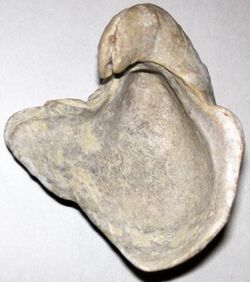Biology:Texigryphaea
| Texigryphaea | |
|---|---|

| |
| Texigryphaea mucronata from the Walnut Formation, Lower Cretaceous of Bell County, Texas | |
| Scientific classification | |
| Domain: | Eukaryota |
| Kingdom: | Animalia |
| Phylum: | Mollusca |
| Class: | Bivalvia |
| Order: | Ostreida |
| Family: | Gryphaeidae |
| Subfamily: | Pycnodonteinae |
| Genus: | †Texigryphaea Stenzel, 1959 |
| Species[1][2] | |
|
About 11 species, see text | |
Texigryphaea is an extinct genus of oyster belonging to the order Ostreida and family Gryphaeidae.[3] It dates to the Albian to Cenomanian Ages of the Cretaceous period and is primarily found in Texas and the southern Western Interior of North America.[1] However, specimens have been identified from northern Spain.[4]
The genus were free-living benthic oysters that were often the dominant species in late Albian biomes of the Western Interior Seaway.[1] Some limestone beds of the Muleros Formation near El Paso, Texas, consist almost entirely of fossil fragments of T. washitaensis.[2] Most species preferred soft substrates in quiet environments, but T. navia was adapted to firmer substrates in more energetic environments.[1] The genus differs from Jurassic Gryphaeidae in possessing a vesicular shell structure and chomata (a fine set of parallel ribs found on the inner valves).[4]
T. tucumcarii is considered to be a synonym for T. pitcheri.[1]
Selected species
- Texigryphaea belvederensis (Hill & Vaughan 1898)
- Texigryphaea corrugata (Say, 1823)
- Texigryphaea gibberosa (Cragin, 1893)
- Texigryphaea graysonana (Stanton, 1947)
- Texigryphaea hilli (Cragin, 1891)
- Texigryphaea marcoui (Hill and Vaughan, 1898)
- Texigryphaea mucronata (Gabb, 1869)
- Texigryphaea navia (Hall, 1856)
- Texigryphaea pitcheri (Morton, 1834)
- Texigryphaea roemeri (Marcou, 1862)
- Texigryphaea washitaensis (Hill and Vaughan, 1898)
References
- ↑ 1.0 1.1 1.2 1.3 1.4 Kues, Barry S. (July 1989). "Taxonomy and variability of three Texigryphaea (Bivalvia) species from their Lower Cretaceous (Albian) type localities in New Mexico and Oklahoma". Journal of Paleontology 63 (4): 454–483. doi:10.1017/S0022336000019697.
- ↑ 2.0 2.1 Strain, W.S. (1976). "New formation names in the Cretaceous at Cerro de Cristo Rey, Dona Ana County, New Mexico; Appendix 2". New Mexico Bureau of Mines and Mineral Resources Memoir 31: 77–82. https://geoinfo.nmt.edu/publications/monographs/memoirs/downloads/31/Memoir-31.pdf. Retrieved 5 August 2020.
- ↑ Cox, L.R. (1971). "Part N errata and revisions". Treatise on Invertebrate Paleontology, Part N, Mollusca 6, Bivalvia 3. Lawrence, KS: Geological Society of America and University of Kansas. pp. N1214-N1217.
- ↑ 4.0 4.1 Hallam, A.; Gould, S.J. (17 June 1975). "The evolution of British and American Middle and Upper Jurassic Gryphaea : a biometric study". Proceedings of the Royal Society of London. Series B. Biological Sciences 189 (1097): 511–542. doi:10.1098/rspb.1975.0071.
Wikidata ☰ Q108889098 entry
 |

